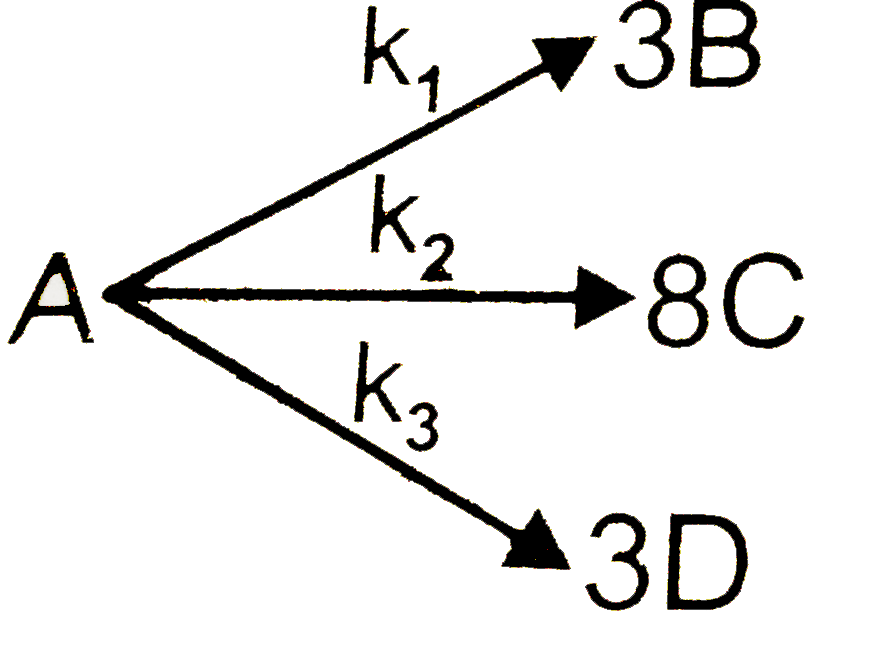 , At time t=0, intial mole of A is 1.
, At time t=0, intial mole of A is 1.
Overall half time of the reaction is 15 days. Then calculate the number of mole of C after 45 days if the raio of is Solution in Punjabi
The correct Answer is:2
Step by step video & image solution for , At time t=0, intial mole of A is 1. Overall half time of the reaction is 15 days. Then calculate the number of mole of C after 45 days if the raio of k_(1):k_(2):k_(3) is 4:2:1 by Chemistry experts to help you in doubts & scoring excellent marks in Class 12 exams.
Topper's Solved these Questions
Similar Questions
Each question contains STATEMENTS-1 (Assertion) and STATEMENT -2 (Reason).
Examine the statements carefully and mark the correct answer according to the instructions given below:
STATEMENTS-1: Acid catalysed hydrolysis of esters is pseudo first order reaction.
STATEMETNT-2:Water is present in excess in given reaction.
a) If both the statements are TRUE and STATEMENT-2 is the correct explanation of STATEMENT-1
b) If both the statement are TRUE but STATEMENT-2 is NOT the correct explanation of STATEMENT-1
c) If STATEMENT-1 is TRUE and STATEMENT-2 is FALSE
d) If STATEMENT-1 is FALSE and STATEMENT-2 is TRUE02:21View Solutionfor the graph below, select correct order of temperture ?
 03:57View Solution
03:57View SolutionFor a gaseous reaction, following data is given:
A→B,k1=1015e−2000/T
C→D,k2=1014e−1000/T
The temperature at which k1=k2 is06:38View SolutionA reaction takes place in theee steps: the rate constant are k_(1), k_(2), and k_(3) . The overall rate constant k=(k_(1)k_(3))/(k_(2)) . If E_(1), E_(2) , and E_(3) (energy of activation) are 60, 30 and 10kJ , respectively, the overall energy of activation is
04:17View SolutionFor the consecutive unimolecular-type first-order reaction Ak1−−→Rk2−−→S, the concentration of component R, CR at any time t is given by -
CR=COAK1[e−k1t(k2−k1)+e−k2t(k1−k2)]
if CA=CAO,CR=CRO=0 at t=0
The time at which the maximum concentration of R occurs is -01:55View SolutionTwo consecutive irreversible fierst order reactions can be represented by Aoverset(k_(1))(rarr)Boverset(k_(2))(rarr)C The rate equation for A is readily interated to obtain [A]_(t)=[A]_(0).e^(-k_(1^(t))) , and [B]_(t)=(k_(1)[A]_(0))/(k_(2)-k_(1))[e^(-k_(1)^(t))-e^(-k_(2)^(t))] At what time will B be present in maximum concentration ?
View SolutionTwo consecutive irreversible fierst order reactions can be represented by
Ak1−−→Bk2−−→C
The rate equation for A is readily interated to obtain
[A]t=[A]0.e−k1t , and [B]t=k1[A]0k2−k1[e−kt1−e−kt2]
When k1=1s−1 and k2=500s−1 , select most appropriate graph01:28View Solution , At time t=0, intial mole of A is 1.
, At time t=0, intial mole of A is 1.
Overall half time of the reaction is 15 days. Then calculate the number of mole of C after 45 days if the raio of k1:k2:k3 is 4:2:1View SolutionA reaction takes place in three steps. The rate constant are k1,k2 and k3. The overall rate constant k=k1k3k2. If E1,E2 and E3 (energy of activation) are 60, 30 and 10 kJ, respectively, the overall energy. Of activation is
01:04View SolutionWrite the equilibrium expressions (K_(C )) for the decomposition of 2 moles of sulphur trioxide and relate it to K_(C ) of the reaction carried out with 1 mole and 4 moles of SO_(3) , respectively.
View SolutionSTATEMENT-1: For a given reaction at fixed temperatures, equlibrium constants K_(rho)and K_(c) are realated as K_(rho)=K_(c)(RT)^(Deltan) STATEMENT-2: Deltan=No. of moles of product - No of moles of reactants.
View SolutionStudy the parallel first order reaction: Aoverset(k_(1))to2B 2Aoverset(k_(2))to3C At any time (tne0) the products contain 40% B and 60% C, by moles .If the overall rate constant for the reaction of A is 0.09 min^(-1) ,then value of K_(1) is :
02:27View SolutionFor the sequential first order reactions: {:(,Aoverset(k_(1)=2xx10^(-4)s^(-1))to,Boverset(k_(2)=10s^(-1))to,C ),(t=0,0.4M ,0,0):} the time after which the concentration of C cecomes 0.3 M is:
05:34View Solution60.A consecutive reaction occurs with two equilibria which co-exist together P(k_(1))/(k_(2) Q (k_(3))/(k_(4) R Where k_(1) , k_(2) , k_(3) and k_(4) are rate constants.Then the equilibrium constant for the reaction P harr R is (1) (k_(1)*k_(2)) / (k_(3)*k_(4) ) (2) (k_(1)*k_(4)) / (k_(2)k_(3) ) (3) k_(1) * k_(2) * k_(3)*k_(4) (4) (k_(1)*k_(3)) / (k_(2)k_(4)) ]]
01:57View Solution, At time t=0, intial mole of A is 1. Overall half time of the reaction is 15 days. Then calculate the number of mole of C after 45 days if the raio of k_(1):k_(2):k_(3) is 4:2:1
04:45View SolutionCalculate the number of moles of Sn^(2+) ion oxidise by 1 mole of K_(2)Cr_(2)O_7 in acidic medium.
02:37View Solution

